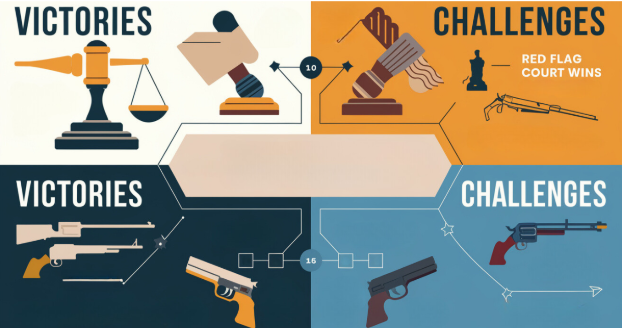Gun Rights
Battle for Gun Rights in 2025: Key Wins and Ongoing Challenges ️
Published
2 days agoon
By
Gun Carrier
Gun rights legislation in 2025 is shaping up as a defining moment for the Second Amendment. With victories in expanding Constitutional Carry and growing threats like Red Flag laws and assault weapons bans, this year is a battleground for freedom. Gun owners, advocates, and lawmakers are engaged in a tug-of-war that will likely shape firearm rights for decades.
Let’s explore the biggest wins and significant challenges and how you can protect your rights.
Gun Rights Victories in 2025
This year has seen significant advancements in the fight for gun rights, with notable wins in legislation and the courts. These developments mark a strong push to restore and protect Second Amendment freedoms nationwide.
Constitutional Carry Gains Momentum
In 2025, two more states—Nebraska and South Carolina—joined the Constitutional Carry movement. This brings the total to 28 states where law-abiding citizens can carry concealed firearms without permits.
Advocates of Constitutional Carry argue it reduces government overreach and restores the Second Amendment’s original intent. Pennsylvania and Louisiana are also actively considering similar bills, signaling a growing trend. Learn more about the movement at the NRA-ILA.
Legal Wins in the Courts
The Supreme Court struck down the ATF’s restrictive pistol brace rule, delivering a massive victory for gun owners. The ruling halted federal overreach and reaffirmed the judiciary’s role in defending the Second Amendment.
Legal experts predict this decision will inspire challenges to other laws, including bans on magazine capacity and semi-automatic rifles. Stay updated on these developments through the Firearms Policy Coalition.
Challenges to Gun Rights ⚠️
Efforts to impose new firearm restrictions continue to gain momentum at both the state and federal levels. These measures spark intense debates over safety, individual rights, and the potential for misuse.
Assault Weapons Bans
Several states, including Michigan and Illinois, have enacted new bans on semi-automatic rifles. Meanwhile, California and New York continue to tighten restrictions.
On the federal level, lawmakers reintroduced an assault weapons ban. While its chances of passing are slim in the current Congress, the push demonstrates ongoing efforts to restrict firearms ownership.
Red Flag Laws Expand
Red Flag laws are growing in number and scope. Virginia and New Mexico recently revised their laws, allowing courts to confiscate firearms from individuals considered threats. Proponents claim these laws save lives, but critics argue they violate due process and are ripe for abuse.
Gun rights groups warn that these laws often rely on vague criteria, leading to potential misuse. To learn more about the risks of Red Flag laws, visit the Heritage Foundation.
Federal Legislation: Competing Proposals
At the federal level, lawmakers are advancing two contrasting bills that could significantly impact gun rights. These proposals highlight the ongoing divide between gun control advocates and Second Amendment supporters.
SAFE Act 2.0
The SAFE Act 2.0 proposes stricter background checks and an expanded list of prohibited persons. Advocates claim it enhances public safety, while opponents argue it unfairly burdens law-abiding citizens.
SHARE Act Returns
The SHARE Act, which protects hunters and deregulates suppressors, has been reintroduced. This bill would also simplify firearm transport laws, making it easier for gun owners to travel between states. However, political gridlock could stall its progress.
States Take the Lead
States are taking bold steps in shaping gun rights legislation, with varying approaches to address local concerns and priorities. These new laws highlight a mix of expanded freedoms and tighter regulations, reflecting the diverse perspectives across the country.
Florida Proposes Lower Carry Age
Florida lawmakers introduced a bill to lower the concealed carry age to 18. Advocates argue that if young adults can serve in the military, they should also have the right to self-defense. Critics raise concerns about public safety and maturity. Supporters also highlight that 18-year-olds already have legal responsibilities, such as voting and signing contracts.
Oregon Mandates Gun Storage
Oregon passed a law requiring gun owners to store their firearms securely. Supporters say it prevents accidents, but opponents believe it makes self-defense more difficult in emergencies. The law also imposes fines for non-compliance, adding financial burdens for gun owners.
Texas Protects Firearm Rights During Disasters
Texas strengthened its laws to ensure citizens can carry firearms during natural disasters. Advocates say this measure allows for better self-defense in chaotic situations. The law aims to prevent scenarios where evacuees are left defenseless in high-crime or unpredictable environments.
Challenges Ahead for Gun Owners
Gun rights advocates face numerous obstacles in 2024. The increasing push for firearm restrictions at both the state and federal levels is creating new hurdles. Additionally, public opinion influenced by sensationalized media coverage often overshadows facts about responsible gun ownership.
- Media Bias: Many media outlets portray gun owners negatively, skewing public opinion and pushing for restrictive laws.
- Emotional Reactions: High-profile shootings lead to calls for legislation that often fails to address the root causes of violence.
- Judicial Delays: Even when courts favor gun owners, the process is slow, leaving restrictive laws in place for years.
By staying informed and active, gun owners can help counter these challenges and advocate for balanced policies.
Looking Ahead: The Future of Gun Rights
The battle over gun rights legislation in 2025 reflects a divided nation. While Constitutional Carry expands, restrictive measures like assault weapons bans and Red Flag laws persist. Gun owners must stay vigilant and work together to protect their freedoms.
Protecting Gun Rights: How You Can Help
Every gun owner can play a role in defending the Second Amendment. Here’s how you can get involved:
- Join advocacy organizations like the Gun Owners of America.
- Educate your community about responsible gun ownership and firearm safety.
- Contact your representatives to voice your opinions on proposed gun laws.
FAQs About Gun Rights Legislation in 2025
- What is Constitutional Carry?
Constitutional Carry allows law-abiding citizens to carry a concealed firearm without needing a permit. - How many states permit Constitutional Carry?
As of 2025, 28 states have Constitutional Carry laws. - What are Red Flag laws?
Red Flag laws allow courts to temporarily confiscate firearms from individuals deemed a threat. - Why are Red Flag laws controversial?
Critics argue they violate due process and can be abused based on vague or subjective criteria. - What is the SAFE Act 2.0?
It’s a proposed federal law that expands background checks and increases firearm restrictions. - What is the SHARE Act?
The SHARE Act protects hunters, deregulates suppressors, and simplifies transporting firearms across state lines. - Are assault weapons bans constitutional?
The Supreme Court hasn’t ruled definitively, but ongoing legal challenges could shape future decisions. - How can I learn more about gun rights?
Follow reputable organizations like the NRA-ILA or Firearms Policy Coalition. - How can I support gun rights?
Join advocacy groups, educate your community, and contact legislators to share your views. - Why is 2025 important for gun rights?
This year’s court cases and legislative battles will likely define gun rights for decades.
Share Your Thoughts!
What’s your take on the state of gun rights legislation in 2025? Have there been victories or challenges in your state? Let us know in the comments below.
You may like


Battle for Gun Rights in 2025: Key Wins and Ongoing Challenges ️

Myths About Revolvers: Unraveling the Truth in 2025

Master the Basics: How to Prepare for Your First USPSA Match This Spring

Everyday Carry Knife: Why Concealed Carriers Shouldn’t Go Without One

Handgun Designs: From Historic Flintlocks to Modern Innovations

Cleaning Firearms Made Easy: Post-Holiday Range Tips for Gun Owners



